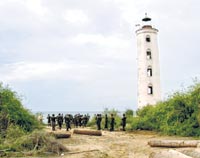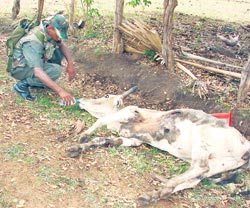|
SAMPUR:
AN INSIDE STORY
The bunkers occupied by Tiger guerrillas
in Sampur 10 days ago are no longer under their control.
It is the same with their offices and sea tiger bases.
All signs that the area was at one time a stronghold
of the guerrillas are still visible.
As government troops secured control
of Sampur early this week dislodging the Tigers after
nearly nine years of LTTE occupation, the Army was preparing
for the next move – to encourage villagers who
fled the area to return to their homes. This could take
a long time as most civilians had fled to the uncleared
areas.
 |
Government troops at Foul Point
in Sampur.
Pic by A.T.M Gunananda |
Some 35,000 Tamil civilians have fled
Sampur, Kattaiparichan and Ichchilanpattu areas of the
Muttur AGA division which saw intense fighting.
A group of journalists were accompanied
by the Army on Thursday to Sampur. It was obvious the
Army had secured the area after a hard-fought battle.
A service station reported to have
been used by the Tigers to service their vehicles and
motorcycles remained in one corner with some of the
vehicles including tractors bearing government emblems
on them.
The offensive aimed at dislodging
the Tigers started from the Selvanagar area on August
27.
 |
| Helping a fallen fourlegged victim
injured during fighting |
There were signs that the school in
the area had been used by the Tigers during the battle
and they had left some items behind while retreating.
Apart from the casualties suffered
by the Army and the LTTE, the livestock too had suffered
a heavy toll. Some of the injured cattle were in their
death throes. One of the moving sights was that of a
soldier trying to give some water from his canteen to
an injured bull gasping for breath.
A sea Tiger base which appeared to
have been used a lot during the recent fighting was
among the locations captured by the security forces.
The Army had put up bunkers at regular
points to consolidate its positions and prevent Tiger
guerrillas re-entering the area.
Lt. Col Sarath Wijesinghe commenting
on the fierce battle, said that as the Army began the
offensive to re- open the sluice gates of Mavil Aru,
the LTTE began an offensive in the areas of Selvanagar,
Kattaiparichchan and Mahindapura forcing the security
forces to retaliate.
In Colombo, on Friday, Defence Spokesman
Keheliya Rambukwella informed Defence Attaches of foreign
mission, about the importance of securing Sampur. He
said the main aim was to neutralize artillery positions
of the rebels. He said Sampur could have been used by
the LTTE as a launching pad for artillery and mortar
attacks on the vitally important Trincomalee harbour,
the naval base, and other economic installations such
as the Prima Flour Co., Tokyo Cement Co. and the Indian
oil tanks.
But, LTTE political wing leader S.P.Thamilselvan
has said that the LTTE views the government’s
capture of Sampur as a move to put an end to the Cease-Fire
Agreement (CFA).
During a meeting with the Norwegian
Ambassador Hans Brattskar on Wednesday, Mr. Thamilselvan
said the LTTE wants the army to withdraw to its positions
before the CFA was signed if they were to resume talks.
Sampur came under LTTE control in
1997 when the security forces reduced their strength
to beef up military operations in other areas of the
Wanni. Since then, the LTTE has been accused of placing
artillery and mortar positions in the area, posing a
threat to the stragic area of Trincomalee.
The area was also used as a landing
point for boats carrying LTTE cadres. This included
boats coming from the north.
Some of the civilians who had fled
Sampur have arrived in Vakarai of the Batticaloa district
necessitating Government authorities to provide them
with food and dry rations.
Batticaloa’s Additional G.A.
K. Mahesan told The Sunday Times that as a result of
the influx of displaced people the total number of people
depending on government assistance has shot up to 59,000.
The figure includes people displaced within the Batticaloa
district.
He said that some of the civilians
who arrived from Trincomalee were from areas that were
neither under the control of the government nor the
LTTE.
This new crisis over displaced people
comes as the government is grappling to resolve the
refugee crisis in Mutur, where some 46,000 people were
displaced due to clashes between the forces and the
LTTE.
As journalists visited the Mutur area
bus loads of displaced persons were seen returning to
their homes . Government officials said more than 25,000
had returned and some 8,000 more were due to return
in the next few days. Those who returned found that
most of their homes had been damaged and they are awaiting
government assistance.
For the displaced people – most
of them still living in Kantale, the situation was worsening
due to the heavy rains and some of the camps going under
water.
“We have spent about three weeks
in the camps and want to return to our homes urgently.
But we need to attend to some repairs before we get
back,” Sitti Fareeda said.
She said many of her relatives and
friends had gone back hoping that the situation would
return to normal soon.
“We don’t want to be displaced
again,” she said.
In addition to the buses provided
by the government to take back the displaced to their
homes in Mutur, some of the displaced were using other
available transport facilities including carts and landmaster
tractors.
In Mutur government officials were
registering those who were arriving to ensure that financial
assistance would reach them. But some of the people
we spoke to were skeptical of getting this relief soon.
|
